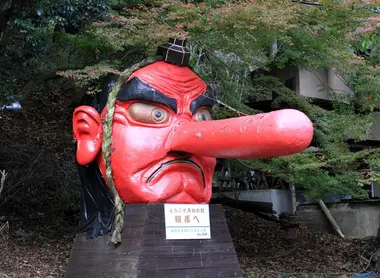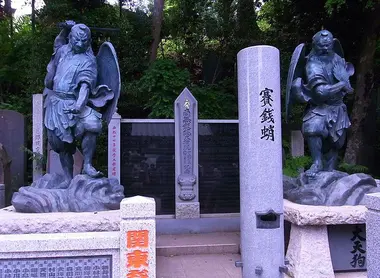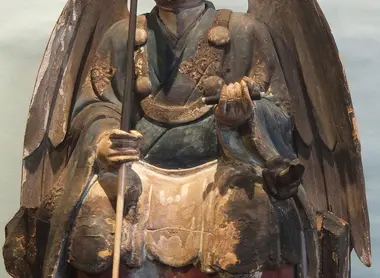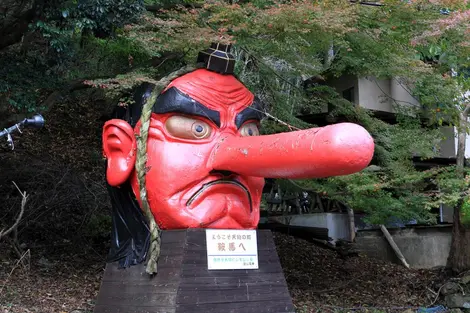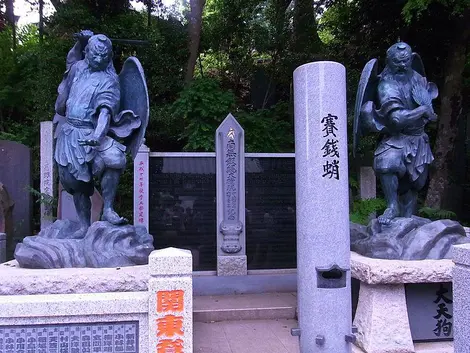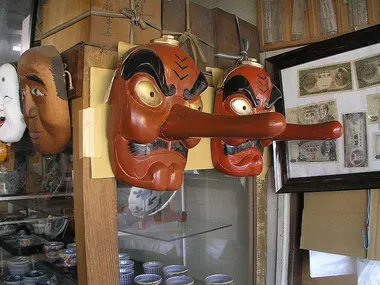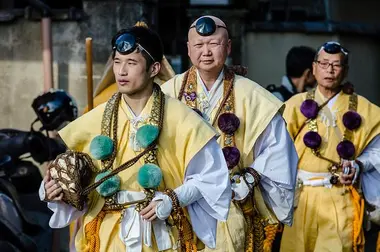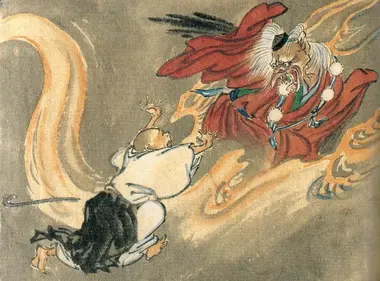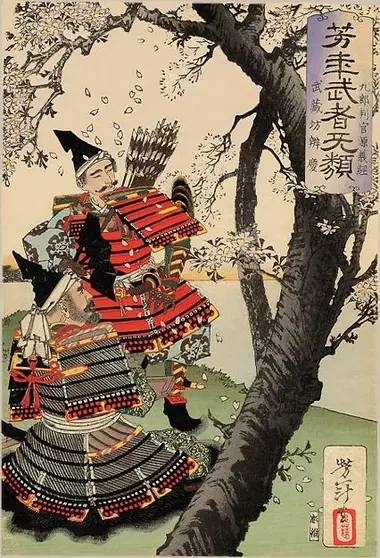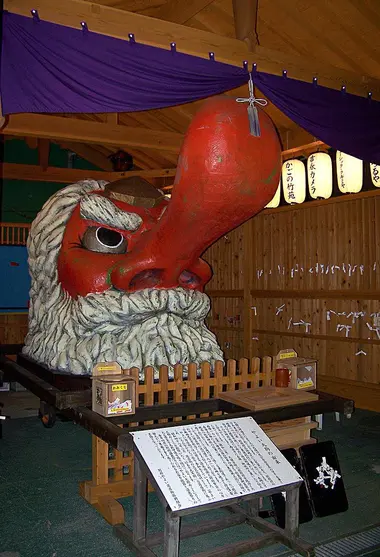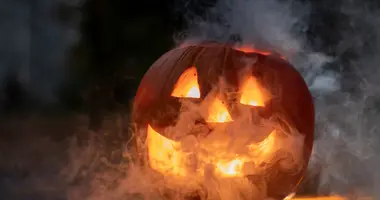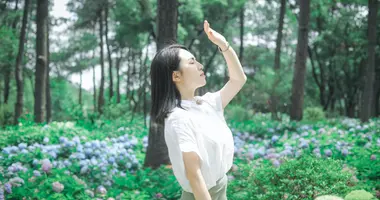The tengu: the long-nosed demon
- Published on : 10/02/2024
- by : S.R. / I.D.O.
- Youtube
The tengu, an emblematic creature of Japanese folklore, has fascinated for centuries with its striking appearance and complex role in Japanese mythology. Half-man, half-bird, this red-faced, long-nosed yokai embodies both threat and protection, oscillating between malevolent demon and tutelary deity. From sacred mountains to Buddhist temples, the tengu has left its mark on the Japanese imagination, evolving over time to become a key figure in popular culture. Let's delve into the mysterious world of this long-nosed demon, whose history reflects the transformations of Japanese society itself.
Origins and evolution of tengu in Japanese mythology
The tengu's roots go back to Japanese antiquity, with mentions in early written texts such as the Nihon Shoki (720). Initially, the tengu was depicted as a creature with canine characteristics, inspired by the "heavenly dog" (天狗, tengu) of Chinese mythology. Over the centuries, its appearance evolved to become more avian, perhaps reflecting the influence of the Buddhist deity Garuda.
The evolution of the tengu is closely linked to Japan's religious history. Initially considered an enemy of Buddhism, it was associated with the vengeful spirits of arrogant or heretical monks. Buddhism and Shinto influenced his perception, gradually transforming him into a more ambivalent figure, both feared and respected.
In the Middle Ages, the tengu became a central character in numerous legends, such as that of the emperor Sanjô, blinded by a vengeful tengu. These stories testify to the growing importance of the tengu in the Japanese collective imagination, reflecting the social and religious tensions of the time.
Appearance and characteristics of the tengu
The tengu's appearance has evolved considerably over time. His crimson-red face, piercing eyes and long nose have become his most recognizable features. This prominent nose, according to the Nihon Shoki, measures "seven palms long" and is an anthropomorphization of an original beak.
The tengu is often depicted dressed like a yamabushi, the ascetic warriors of the mountains. He usually wears a priest's robe, a distinctive hat and holds a feather fan (ha-uchiwa) symbolizing his power over the wind. His wings, a vestige of his avian origins, enable him to fly and reach places inaccessible to humans.
The tengu's physiognomy reflects his complex nature: at once terrifying and majestic. Its facial expression, often grimacing or angry, reflects its reputation for pride and vindictiveness. Indeed, the Japanese expression "tengu ni naru" (to become a tengu) refers to a person who has become arrogant, underlining this emblematic characteristic of the character.
The different types of tengu
Japanese mythology distinguishes two main types of tengu: daitengu and kotengu. The daitengu, or "great tengu", are the most powerful and the wisest. They have a more human appearance, with the famous long red nose. Among the most famous daitengu is Sōjōbō of Mount Kurama, reputed to have taught martial arts to the legendary samurai Minamoto no Yoshitsune.
The kotengu, or "little tengu", are less powerful and closer to their original avian form. Often referred to as karasu-tengu (crow tengu), their appearance is less anthropomorphic and wilder. These kotengu are generally regarded as the servants or subordinates of the daitengu.
There are also other regional variations of tengu, such as guhin or kawatengu, each with their own characteristics and associated legends. This diversity testifies to the richness of tengu folklore across Japan, each region having developed its own traditions and beliefs around these fascinating creatures.
Roles and powers attributed to tengu
Tengu are renowned for their many supernatural powers. They excel in controlling the elements, especially the wind, which they manipulate with their magic fan. Their ability to fly and their superhuman speed make them formidable adversaries.
One of the most famous characteristics of the tengu is their mastery of the martial arts. Japanese martial arts are often associated with these creatures, who are said to have passed on their techniques to great warriors such as Minamoto no Yoshitsune. This reputation has helped make the tengu a respected figure in Japanese martial tradition.
Tengu are also known for their ability to metamorphose and create illusions. They can possess humans, abduct them or lead them astray in the mountains. These powers reflect their ambivalent nature: sometimes malevolent, sometimes protective, they embody the mysterious forces of nature.
Over time, the role of the tengu has evolved. Initially regarded as enemies of Buddhism, they have gradually become guardians of the mountains and forests. Some are even venerated as protective deities, able to grant favors to humans who respect them.
The tengu in Japanese popular culture
The tengu occupies an important place in modern Japanese popular culture. They appear in numerous manga, anime and video games, where they are often portrayed as powerful and mysterious characters. For example, in the manga "Demon Slayer", the character Urokodaki Sakonji wears a tengu mask, illustrating the persistence of this figure in the contemporary imagination.
Traditional festivals continue to celebrate tengu. The Shimokita Tengu Matsuri festival in Tokyo, held every February in the Shimokitazawa district, is a living example of how these mythical creatures remain rooted in popular culture. During this festival, a parade featuring tengu roams the streets, handing out lucky beans.
The image of the tengu is also used in marketing and design, appearing on masks, decorative objects and even food packaging. This ubiquity testifies to the continuing fascination the tengu exerts on modern Japanese society, transcending its mythological origins to become a cultural symbol in its own right.
Where to meet tengu in Japan
Although tengu are mythical creatures, many places in Japan are associated with their legend. Mount Kurama, near Kyoto, is particularly famous for its association with Sōjōbō, the king of the tengu. Visitors can explore the Kurama-dera temple and surrounding hiking trails, imbued with the mystical atmosphere linked to the tengu legends.
In Tokyo, Mount Takao is another site renowned for its tengu connections. The Yakuo-in temple, located on the mountain, houses tengu statues and organizes festivals in their honor. It's an ideal place to discover tengu folklore while enjoying a picturesque hike.
Several festivals across Japan celebrate tengu:
- The Numata festival in Gunma prefecture, where large tengu masks are paraded through the streets.
- In Osaka, an October festival allows women to be "touched" by a tengu to ensure healthy children.
- The town of Furubira in Hokkaido organizes festivals where tengu walk on fire.
For travellers interested in exploring these mythical places, why not rent a car to visit Gunma on your own? Or discover Nagano on one of our organized tours! to visit Mount Izuna, home of the famous tengu Izuna Saburō.
Meaning and symbolism of the tengu in Japanese culture
The tengu embodies a profound duality in Japanese culture. Both demon and deity, he symbolizes the mysterious forces of nature and the complexity of spiritual experience. Its evolution from enemy of Buddhism to protector of the mountains reflects changes in religious and philosophical perception in Japan.
In the martial arts tradition, the tengu represents ultimate mastery and hidden wisdom. Its association with the martial arts makes it a symbol of excellence and discipline, inspiring practitioners to transcend their human limitations.
The tengu's long nose has become a symbol of arrogance and vanity in Japanese culture. The expression "tengu ni naru" (to become a tengu) warns against the dangers of excessive pride, reminding us of the importance of humility in Japanese society.
Today, the tengu continues to fascinate and inspire, serving as a bridge between the mythological past and the present. He embodies Japan's ability to preserve its traditions while reinventing them for future generations. The tengu thus remains a powerful symbol of Japanese cultural identity, reminding us of the importance of balancing respect for tradition with openness to change.
For those wishing to deepen their understanding of traditional Japanese culture, And to discover an authentic and bucolic Japan at the gateway to Kyoto, offers a unique experience in the heart of the landscapes that have nurtured these fascinating legends. To discover a mystical Japan, discover our tour by car: L'âme Shinto Dans Les Embruns (The Shinto Soul in the Sea Spray), which will plunge you into the spiritual atmosphere that gave birth to the legends of the tengu and other mythical creatures of Japan.
